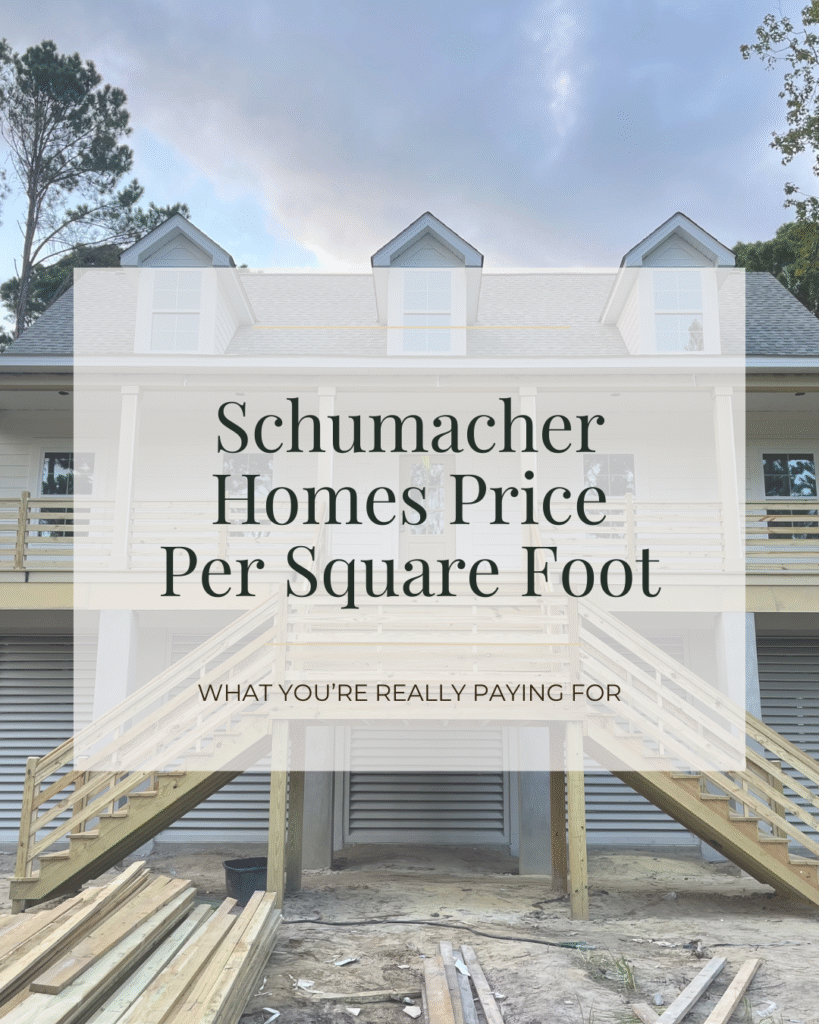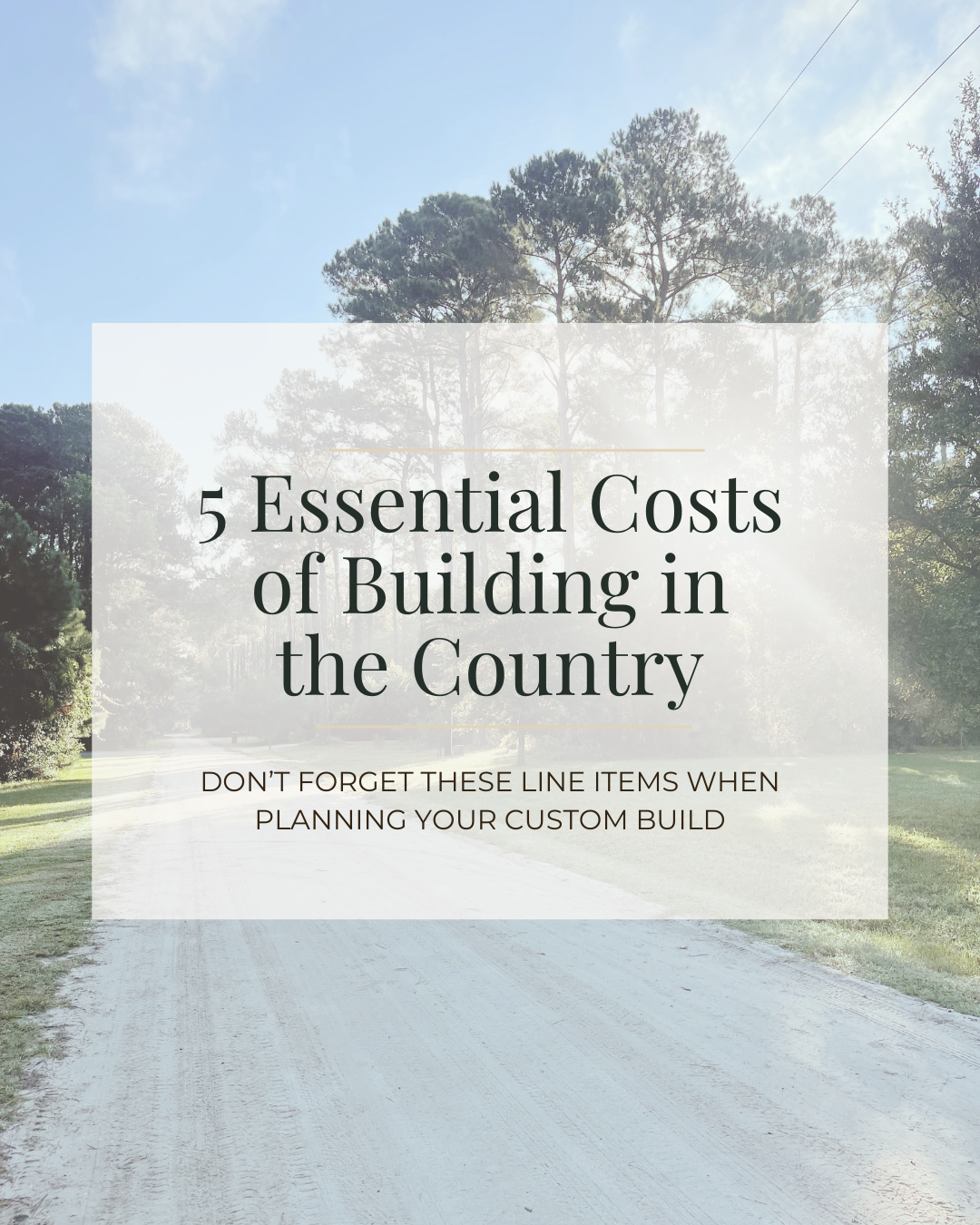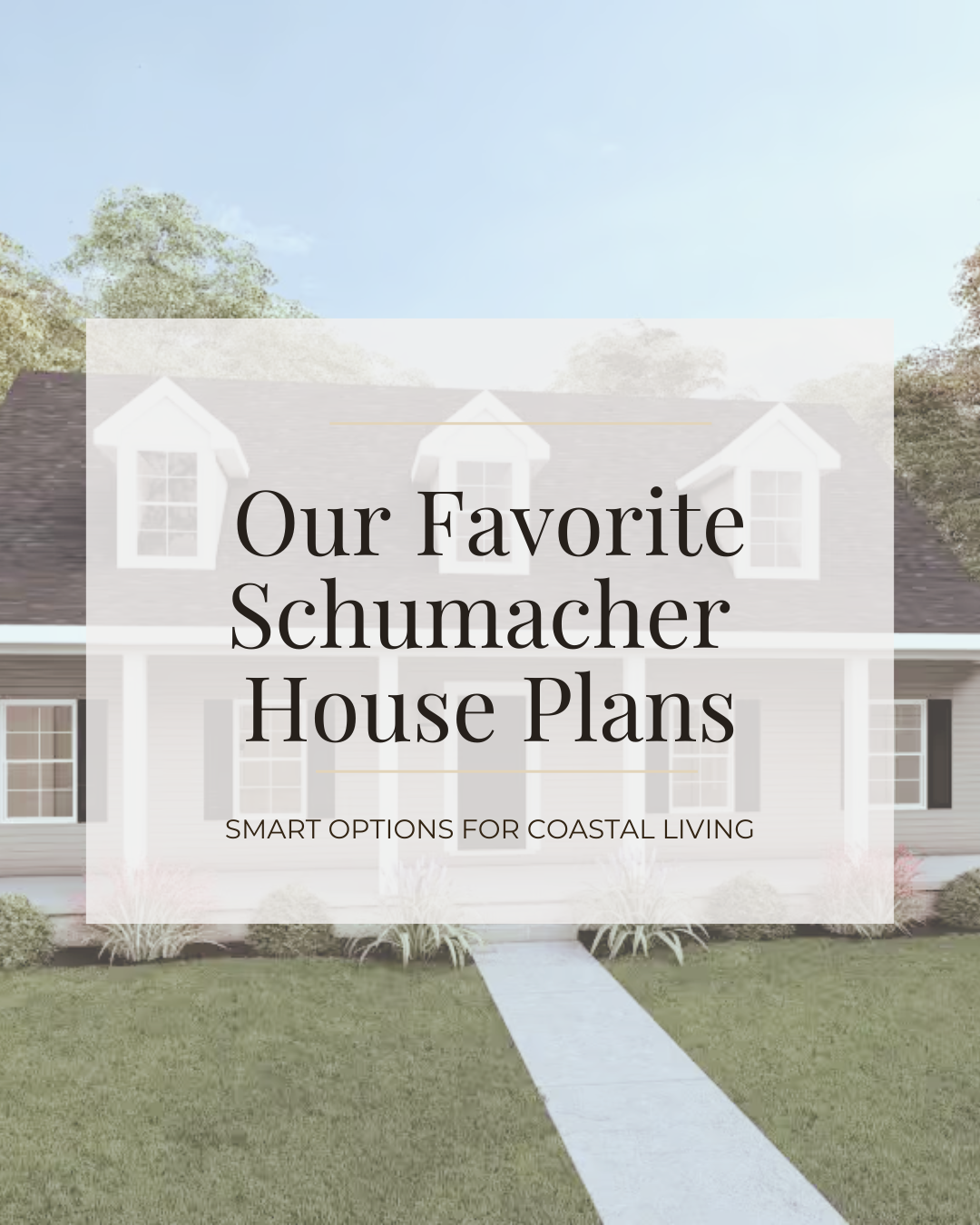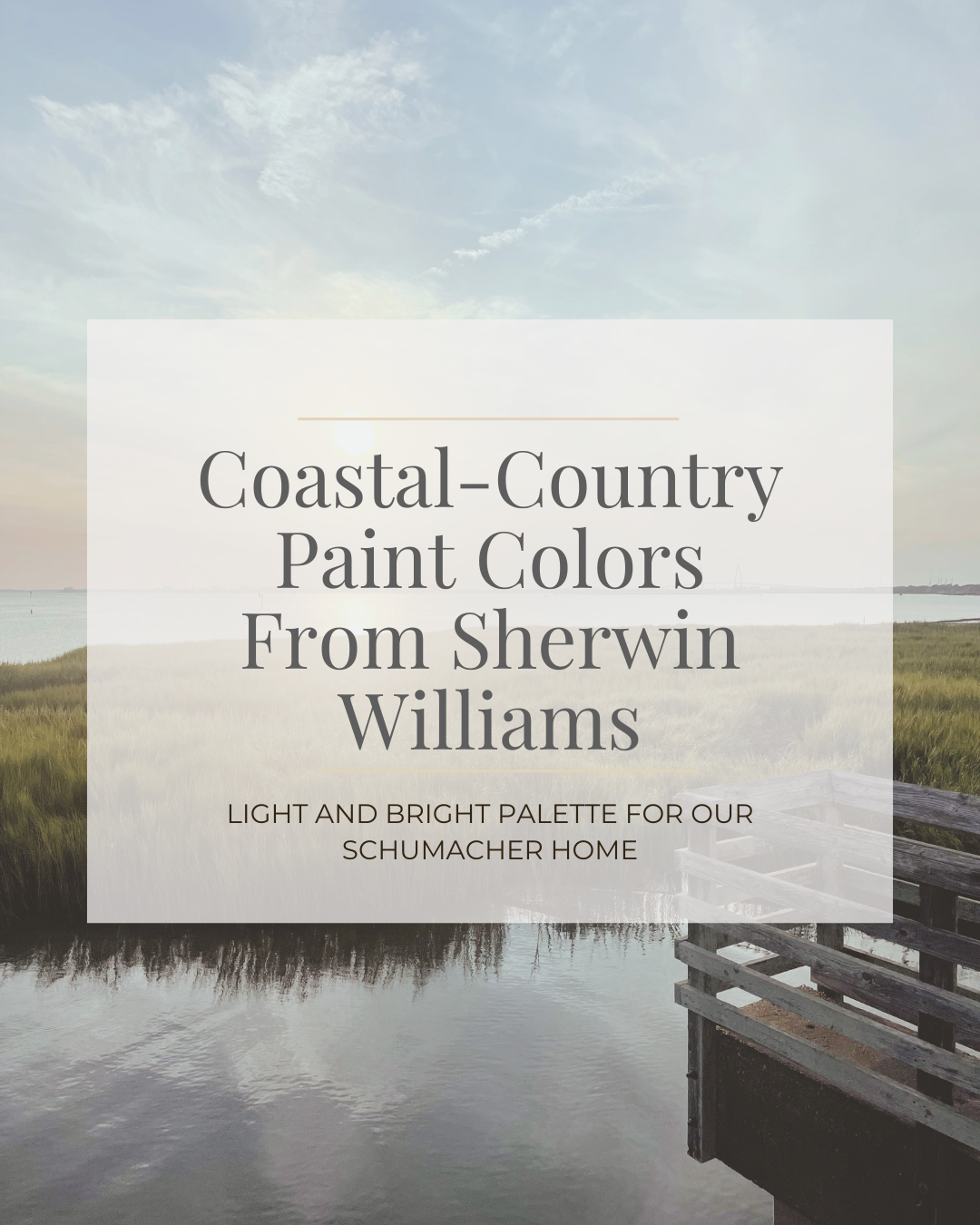If you’re building (or even thinking about building) with Schumacher Homes, there’s one question you’ve probably typed into Google:
“What’s the price per square foot?”
We sure did. A lot.
But the truth is, that number doesn’t mean much until you dig into the details. So in this post, we’re breaking down exactly what the base price does (and doesn’t) include, what we actually paid, and how you can avoid budget shock halfway through your planning.
Base Price ≠ Final Cost
Our floor plan is the Meadowview, one of Schumacher’s more traditional layouts as far as the exterior aesthetic. On the interior, the home is actually quite “modern” in that is is an open-concept main floor. The base price for the American Tradition version? $334,615.
We chose the American Tradition elevation — a Cape Cod–style design — which looks quite different on elevated foundation to account for our flood zone.
We actually loved the Farmhouse-style elevation on the Meadowview too, but we ended up sticking with the American Tradition. Why? It saved us money and felt like a better fit for the area, which is surrounded by historic homes. Going too modern would’ve clashed with the neighborhood’s vibe (and probably raised more eyebrows with the review board).
But that base price? It’s just the beginning.
Here’s what it doesn’t include:
- Land
- Septic or well (or tap fees for city services)
- Driveway + utility connections
- Tree clearing, grading, or elevation work
- Permitting fees
- Any “non-base” finishes or upgrades
At $334K, we knew it was too good to be true. Homes near the coast at our modest size of ~2,500 square feet are almost always at least $750K, if not closer to $1M. What wasn’t immediately clear, though, was what exactly that base price left out.
Yes, there are “included” items in Schumacher’s base pricing — but even if you picked zero upgrades (which is basically impossible unless you’re treating this as an investment property instead of your family home), it still doesn’t cover so many necessary items you’d need to add anyway.
For us, it stacked up fast:
- Vinyl siding is included, but wasn’t allowed → upgrade to HardiPlank®.
- Foundation upgrades for elevation (just to meet zoning).
- Rear porch add-on (front porch was included, but had to be elevated = extra $$).
- Small loft + additional bedroom for function.
- Mostly “level 1” finishes to keep upgrades minimal.

Local Zoning Can Override Builder Inclusions
We originally planned to use Schumacher’s included vinyl siding — but since we’re building in a historic district, vinyl wasn’t allowed.
So we had to upgrade to HardiPlank® siding — a beautiful choice we don’t regret, but one that cost tens of thousands more than expected.
Moral of the story: Zoning and HOA rules can override your builder options. Always ask what your specific lot requires — and be ready to pivot with your wallet.
Our Real Cost Per Square Foot on the Schumacher Meadowview
While the builder quote started around $140/sq ft, we quickly realized that number didn’t tell the full story.
By the time we added:
- Pre-construction costs
- Engineered septic ($38K curveball)
- Additional bedroom upstairs
- A few modest interior upgrades
- Foundation elevation
- Required siding upgrade
- Land costs
…we landed at ~$336/sq ft all in (including our land, purchased in summer 2024).
And we didn’t splurge. We made smart, aesthetic choices — and still got asked by our builder to host an open house because our design looks clean, attractive, and makes sense for family life.
The septic was probably the biggest shock. We obviously knew we’d need a septic system and a well in a rural area without town hookups, but we weren’t expecting it to be that extreme. Early estimates we got just from asking around were much lower, so when the actual bid came in at $38K, it stung — and it was completely unavoidable.
The siding was another major hit to the budget, but one we would call absolutely worth it. Upgrading from vinyl to HardiPlank® truly elevates the feel of the home. Once you see the difference between vinyl and HardiPlank®, it’s hard to unsee it. That choice added cost, but it also added timeless curb appeal we’ll appreciate every day.
And even features that were technically included in the base design came with hidden costs. Our front porch was part of the Meadowview plan, but because our house had to be built on an elevated foundation, the porch had to be elevated as well — which meant extra dollars on top of “included.” It all adds up, fast.
What Impacts Schumacher Homes’ Price Per Square Foot?
There’s no universal “standard” number, but here are the biggest factors that drive it up or down:
- Lot location + condition (flat vs flood zone, trees vs cleared)
- Foundation type (slab vs crawl vs elevated)
- Exterior elevation style (Heritage, Craftsman, American Tradition, etc.)
- Local zoning + HOA rules (what materials are allowed)
- Site prep (tree removal, grading, septic engineering)
- Code requirements for utilities
- Design center upgrades (this is where costs can balloon fast)
When it came to the design center, we had to think really carefully ahead of time about what was a must-have and what was a nice-to-have. In other words: what could we happily live with for the next 3–5 years that would still give us the look we wanted, even if it wasn’t our first choice?
- For floors and tile, we went practical. We upgraded from the included LVP to level 1 hardwood, but stopped there instead of jumping to a level 4 that would’ve added thousands more.
- For cabinets, we chose a less expensive cabinet face, but had them painted so we still got the aesthetic we wanted without blowing the budget.
- For counters, we chose the lowest-cost level 1 quartz instead of included granite — again, a modest upgrade that achieved the look without the splurge.
With that said, we also gave ourselves room for intentional splurges where it mattered most to us:
- A porcelain farm sink that made my kitchen feel like my kitchen.
- A fully tiled primary shower that will stand the test of time and feel like a small luxury every day.
Bottom line: It’s all about balance. Spend strategically on the things that define your home’s vibe, and save on the choices you can upgrade later without regret.
FAQ: Schumacher Homes Cost Per Square Foot
Q: What is the average price per square foot to build with Schumacher Homes?
Online you’ll see numbers like $140–$200/sq ft — but that’s just the base. Our Charleston build came out closer to $336/sq ft all in.
Q: Does the price per square foot include land?
No. Land is never included. We purchased our lot separately in 2024, which added to our all-in cost.
Q: What’s the biggest hidden cost?
For us, it was the foundation ($83K with porches) and the septic ($38K). Both were required for our lot, and neither was obvious when we started.
Q: Is upgrading siding worth it?
In our opinion, yes. Upgrading from vinyl to HardiPlank® added significant cost, but it also elevated the curb appeal and durability of our home. Once you notice the difference, it’s hard to unsee.
Q: How should you approach design center upgrades?
Go in with a clear plan: know your must-haves vs nice-to-haves. Save on finishes you can upgrade later, and splurge intentionally on items that define your daily experience (like a farm sink or a primary shower).
Want to Budget Smarter?
We tracked every single cost — from soil tests to our kitchen sink — in a simple Google Sheet we still use today.
Grab our FREE Build Budget Starter Sheet to see our real numbers and start planning your own build without surprises.




